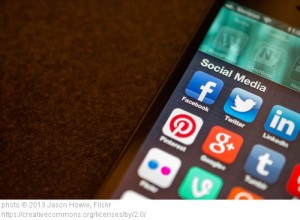(If you don’t know what I’m talking about when I refer to The Dress, read this first.)
My first thing:
If you are a blogger or content curator or hold some other job title that didn’t exist before 2004, and you’ve been busy figuring out what exactly made The Dress go viral, because you want to learn if there’s something that someone did to cause this to go viral that you can do too…
Stop it. Stop it now.
Why did The Dress go viral? Paul Ford suggests that The Dress phenomenon, which started with a Tumblr post picked up by BuzzFeed, was due not to technical or strategic wizardry, but to a workplace culture. Ford wrote that BuzzFeed,
…didn’t just serendipitously figure out that blue dress. They created an organization that could identify that blue dress, document it, and capture the traffic. And the way they got those 25 million impressions, as far as I can tell from years of listening to their people, reading their website, writing about them, and not working or writing for them, was something like: Build a happy-enough workplace where people could screw around and experiment with what works and doesn’t, and pay everyone some money.
Those of us trying to make a living by sharing words, images, and ideas online want to believe that posts go viral because they’re brilliant, or we use the right key words, or they’re tied to a big news story. But it’s actually really hard to predict what will go viral, and surprising to see what does. Viral posts appear almost magical, because they arise not as much from strategic decisions as from less technical, less predictable factors, such as serendipitous timing or, if Paul Ford is right, workplace culture. Viral blog posts, in other words, happen organically rather than strategically. It’s a lot like gardening; you don’t produce a beautiful garden by purchasing the prettiest plants and sticking them in the ground, but by spending years building up healthy soil and figuring out which plants do best where. For BuzzFeed, an environment that produces shareable content might rest on their workplace culture. For me, with a very different focus, audience, and purpose than BuzzFeed, a productive environment for writing requires doing lots of reading and ruminating before sitting down to write.
That last sentence might beg the question: Why am I writing about The Dress anyway? Surely this post didn’t come only after reading and ruminating for weeks, given that The Dress phenomenon is only a few days old. It might even look like I’m strategically writing about The Dress to get a few more clicks and shares than usual. All I can say is that I am truly not interested in jumping onto a social media bandwagon so I can get a few more clicks than a blog post on kids or Jesus or disability would get. I’m writing about The Dress because talking about The Dress over the weekend with friends led me to an insight that I think is actually valuable, which I’m getting to. But first….
My Second Thing:
Contrary to what some commentators think, The Dress phenomenon is not a primary example of how shallow and silly social media has become, as we debate the color of a dress while far more serious news deserves our attention. Certainly, debating the color of a dress is trivial compared with complex and tragic happenings around the world. That doesn’t make it meaningless or a complete waste of time, even if its only benefit for some people is a few minutes of befuddling and fascinating conversation with friends. As my friend Karen wrote for Christianity Today:
Outcries that the whole fuss was a waste of time are nonsense, unless, I suppose, objectors contend that as long as evil and injustice exist, there can be no more laughing and no more fun (a position as silly as it is inhumane). One friend wryly announced on her Facebook page: “To all the Jesus-juking dress haters who think this is too trivial to discuss…you’re on Facebook. So shush.”
For me, conversation with friends about The Dress was more than just a fascinating few minutes of distraction from weightier matters. Which leads me to….
My Third Thing:
This weekend I attended, with two other old friends, a memorial service for the father of my best friend from high school. After the service, we were hanging out, snacking and talking, when The Dress came up. My friend A., whose dad had just died, saw The Dress as blue and black, as did her mom and sister. I and several others clearly saw white and gold. A. was having trouble taking in this discrepancy. She asked us, only partly joking, if we had gotten together ahead of time and planned to tell her the wrong colors, in some kind of conspiracy to make her think she was losing her mind. (This was, I’ve heard, a fairly common reaction from people who saw the dress differently than their friends did.) Our conversation was indeed fascinating, but it was a little disturbing and uncomfortable too, as we realized that nothing we said or did could convince anyone to see The Dress as we did. Our differences were absolute and—unlike with more traditional optical illusions—unchanging and unchangeable.

What makes The Dress phenomenon so remarkable—and so different from other differences of perception—is that we perceive color as an objectively observable phenomenon, akin to the weather or the time. When discussing a political or social issue with someone who has a different opinion, we understand that even our deeply held opinion is subjective and imperfect, no matter how much faith we have in the facts and statistics on which we base it. We may get exasperated, we may think the other person is dead wrong. But we’re not normally left wondering if something is actually wrong with us—or if everyone else is in a conspiracy against us—because we have a different opinion about Obama or guns or Social Security than our friends do. With The Dress, we had to confront the fact that we saw something that other people didn’t see at all, and vice versa—which goes beyond exasperating to mind-boggling, confusing, and upsetting. We were feeling the same way we would feel if we said to our spouse, “It’s 8:30. I’m leaving for work,” and our spouse responded, “No, it’s 8:30 at night. You should be getting ready for bed.” Reality itself seemed to become a matter of opinion.
Earlier in the evening, my friends and I had been talking about another high school friend who has severe mental illness. As I told them, this friend leaves long and frequent messages on my answering machine in which she tells me things—about what she has done and will do, her relationships, her history, her future plans—that I know are not true. She also tells me that she is mentally healthy and has no idea why she is in a psychiatric ward. As we talked about The Dress around the table on Saturday night, we realized just how awful it must be for our old friend to have everyone tell her that the things she knows, observes and feels are simply not true.
I’ve always felt sympathy for my friend, I’ve always ached for all that she has lost in her years of cycling in and out of psychiatric wards. But The Dress led me to a deeper level of empathy. This was the first time I understood how very frightening and disorienting it must be to see the world one way, and to have others tell you that, no, that’s not at all how it is.
I don’t want to make more out of this than it deserves. The Dress doesn’t help me know what it feels like to live with mental illness, any more than your dealing with a broken arm means that you know what it’s like for me to live with my genetic bone disorder. That The Dress increased my empathy for my friend is also unlikely to have any practical implications. I have, in years past, done things for and with her (meals, letters, hospital visits, etc.) Now, I rarely pick up the phone when she calls. I’ve told her that until she begins to participate in her own mental health care, I cannot help her.
But at least our conversation about The Dress, about how jarring and awful it is to understand that no one else sees what you see, will increase and direct my prayers for my friend, prayer being the one thing I can still do.
In this divided world, our different perceptions of what’s real and true, what’s important and not, lead to political gridlock, online vitriol, social disparity, violence in the name of God, and more. A viral social media phenomenon that helps us understand just how fundamental and deep our differences in perception can be—and that those perceptions have nothing to do with whether we are caring, thoughtful, and wise or callous, shallow, and silly—is more than a meaningless distraction.
(Let’s just please not obsess about how to mimic its viral success. We will fail.)











